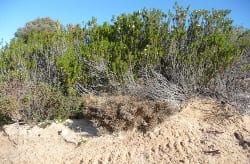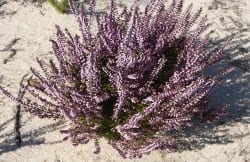by Joao Oliveira
If I look at nature only and forget cars, houses, and signs, I might say that I live in California. Instead, I am in Portugal where there is great natural diversity, such as you might find along the coastline from Southern California to Oregon. But the Portuguese Shore is only 500 miles long.
On this side of the Atlantic, it does not look much different than that western side in the Americas. Is it something to do with the logic of the world that Western Europe has similar conditions – climate, plants, and animals – as the western United States? Nature applies the very same logic in both places by finding the most efficient form or the less energy consuming option. Likewise, we find ourselves in our everyday thoughts finding the most efficient shape for a garden and the most adaptable plant for that very shady corner or the sunny front. Humans emulate nature by looking for the best solution and adapting to the environment.
Portugal is in the southwest corner of Europe, and our Mediterranean weather offers many similarities to the weather found from Southern California to Oregon. So we have some plants in common. I find that there are many plants native to Portugal that I like to use in my designs.
Favorites for Every Use
Two of my favorite native plants are Rosmarinus officinalis and Lavandula stoechas. These plants are probably great
choices worldwide; we find then in landscape architecture everywhere in the world. They are very fashionable even in English gardens, and with the English weather, they will thrive. If I walk alongside the shore here, I find many beautiful specimens of both these plants.
However, my two nominees for absolute favorite native plants are Corema album and Santolina chamaecyparissus.
Corema has a white and very acidic fruit that you can eat. It is very difficult to grow in nurseries; only a few have the knowhow to produce them.
Santolina with a fantastic grey green leaves and yellow flowers makes a beautiful planting no matter whether in the wild or in your garden.
Another native plant that grows very well here is Arbutus unedo. You can also eat the fruit of this plant or use it to make a very popular alcoholic drink. Leaves and trunk has a reddish taw and fruits change from green to orange and red when they are ripe.
Myrtus communis and Pistacea lenticus are plants that make huge shrubs in appropriate conditions. Also, they work very well in the wild, in forests, along hills, or in private and public gardens.
Another of my favorite plants is Thymus carnosus. They look dry the year round but make a fantastic ground cover.
Cistus ladanifer is one of the most tolerant plants. They grow almost everywhere, and their only downside is that their beautiful flower only lasts for a few days.
Erica lusitanica is another plant that you will probably find everywhere in the world, but they make such a beautiful ground cover.
Some Juniperus turbinate are unruly specimens and have a tree look, but most have a shrub type size.
This Festuca is very popular in sandy soils and is very drought resistant. I love fescues, and this one in particular because of its chromatic variation through the year, from green in the winter to gold when it flowers to light brown in the peak of the summer. It is one of my favorite plants because of its very good potential in Landscape Architecture.
Of the tall trees, my nominees for favorite natives are Quercus suber and the Pinus pinea. With its majestic look, Quercus suber is responsible for an important asset in the Portuguese economy, the cork. Where you find fine wine, it will probably be sealed with the skin of a Portuguese cork tree, whether some vintage Port wine or a world famous Champagne. The good thing about the cork is that you can remove the skin every eight years and it will renovate itself, without harming the tree.
Pinus pinea, besides making a beautiful tree, provides the Pine nuts that are responsible for famous desserts such as pine nut cookies and more.
All these plants are fully adapted to the Mediterranean climate. If you want to use them in the landscape, after one or two years of irrigation for their establishment, they need hardly any irrigation. In the wild, all of these native plants are fully adapted to the traditional long and dry summers, but seeds will find the cooler and wetter years to establish themselves.
A natural response for increasing shortage of water worldwide, homeowner and landscape architects are more prone to use native plants in private and public gardens. In Portugal, nature has provided us with many beautiful native plants that will suit most circumstances.
About the Author
Joao A. Oliveira is partner of Green Garden & Golf in Alentejo, Portugal. Our main focus is providing support on local golf courses and building and maintaining gardens. One of the most successful areas is renovating existing gardens to become low maintenance and water saving gardens. We are also introducing Gourmet Gardens and Rural gardens to our customers. Joao holds a Bachelor Degree in Agriculture from the Beja Agriculture College with a specialization in TurfGrass Management, and he has 18 years of experience working for a landscape and golf contractor. You may reach him at joao.anes.oliveira@gmail.com.















